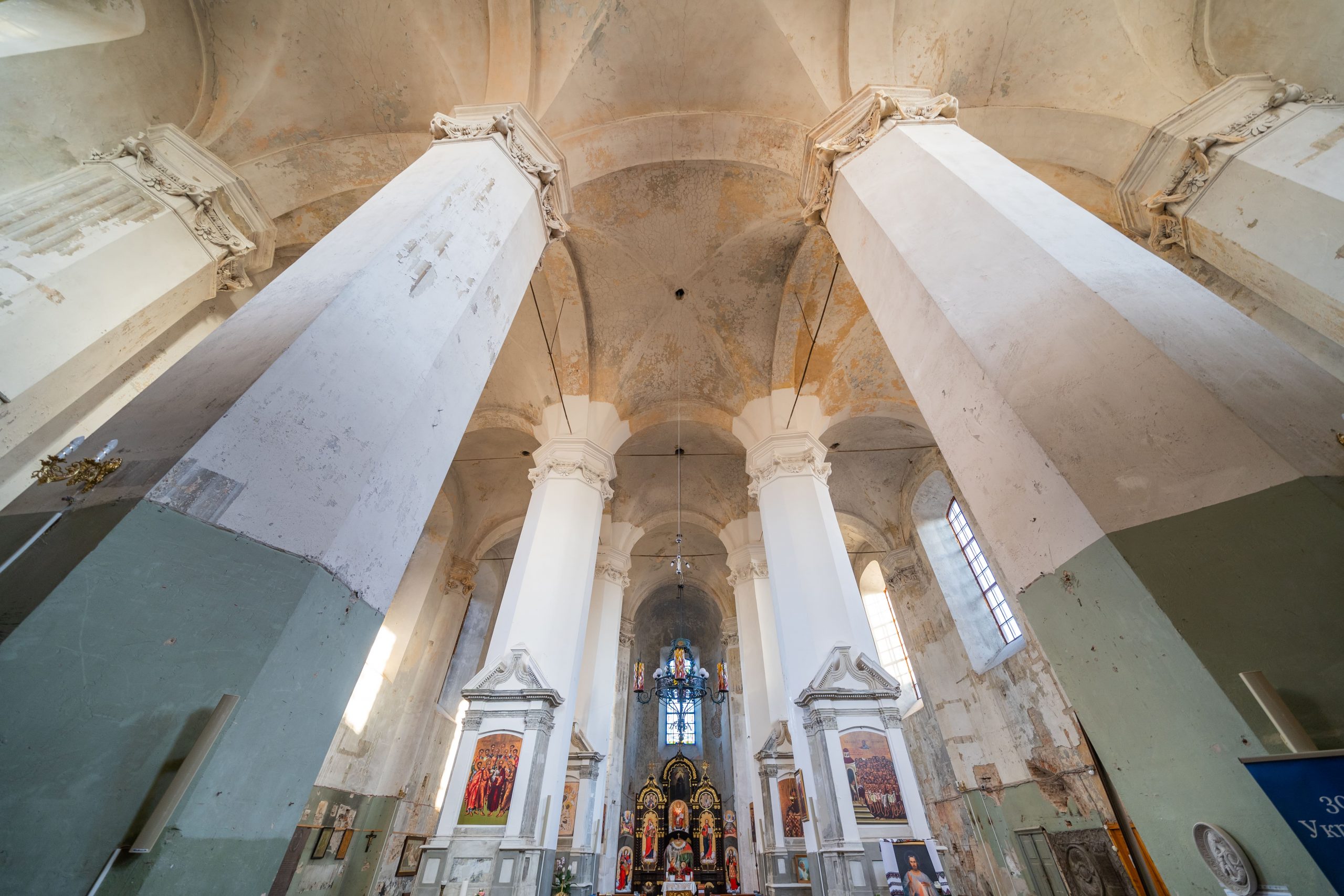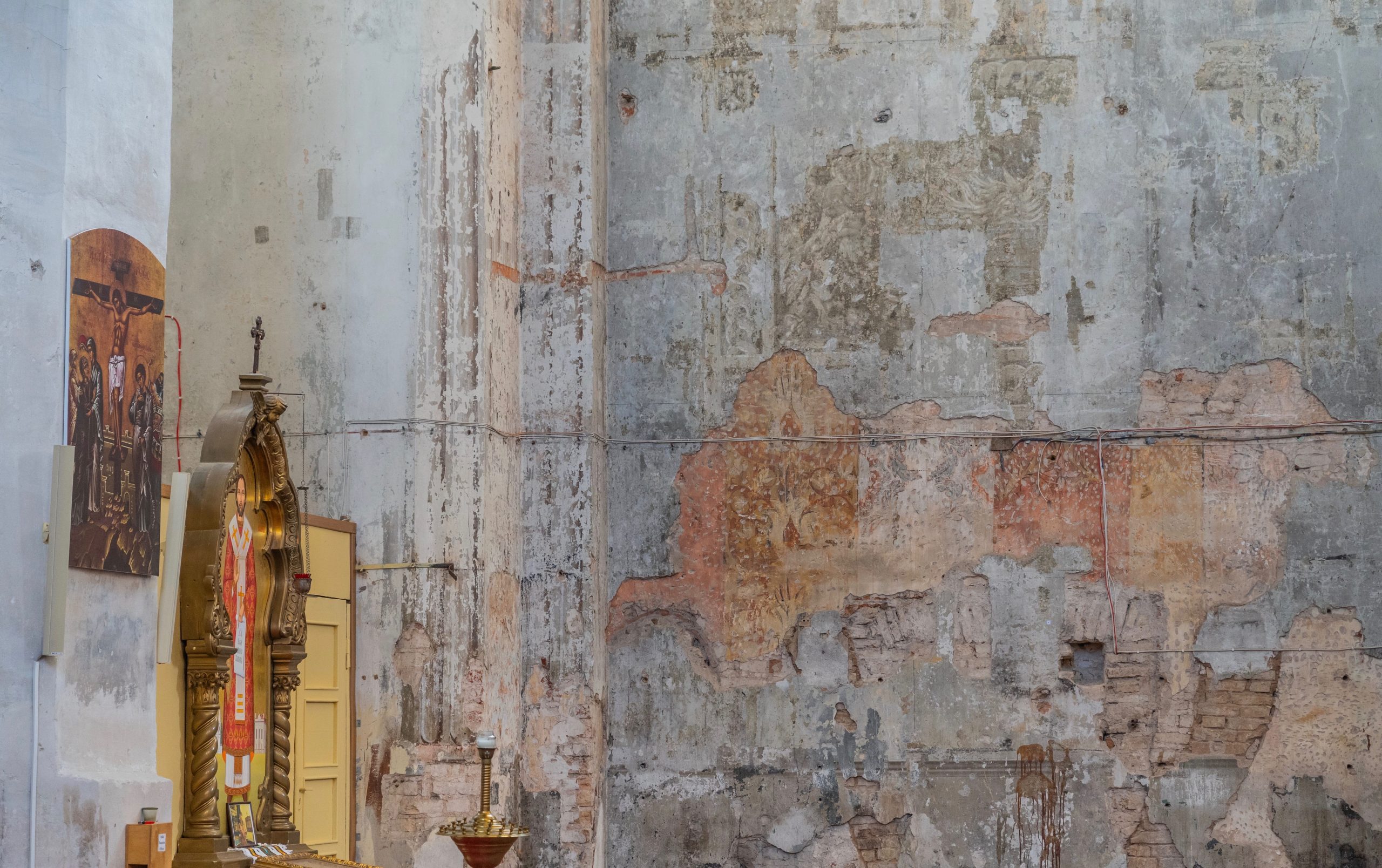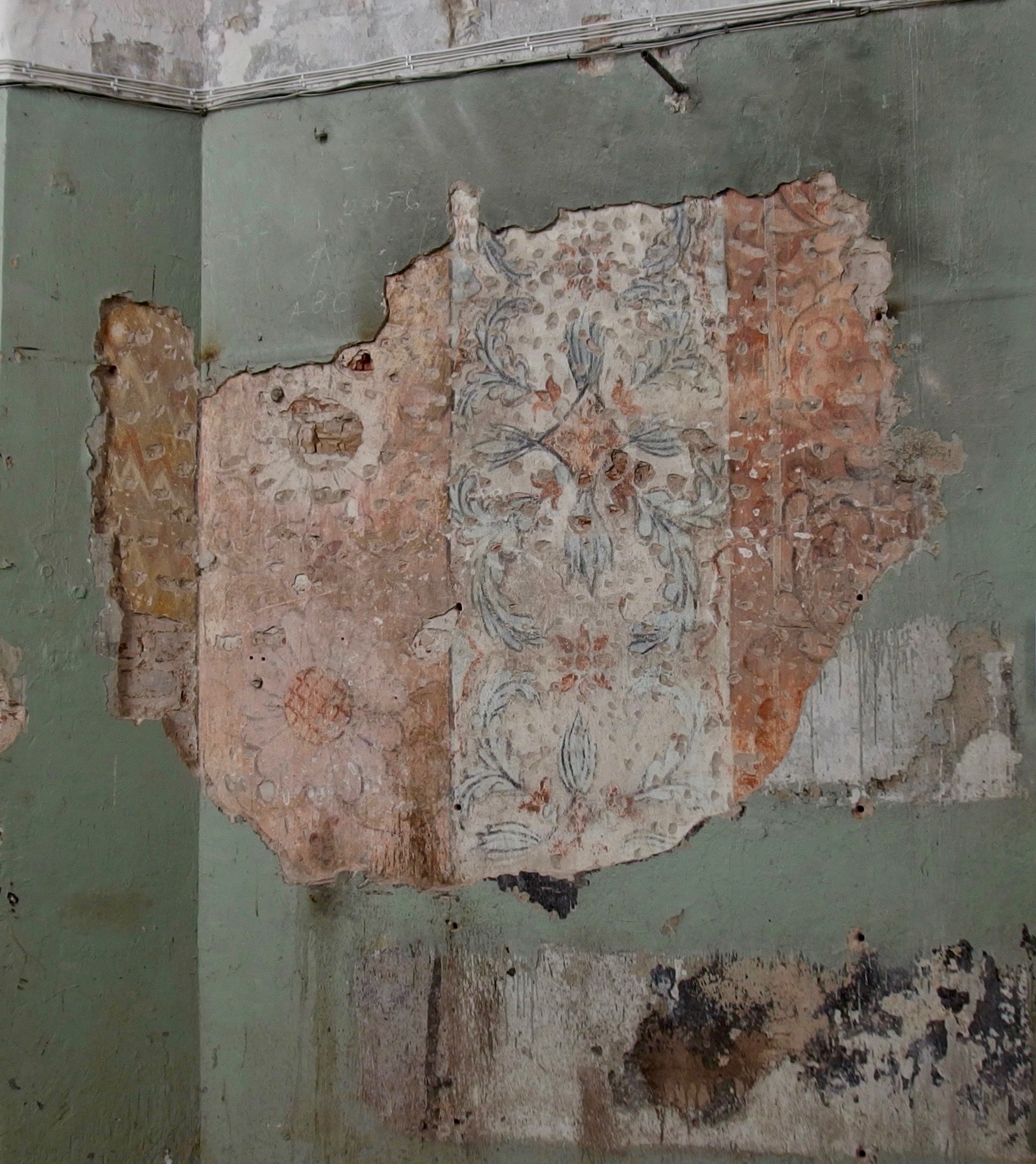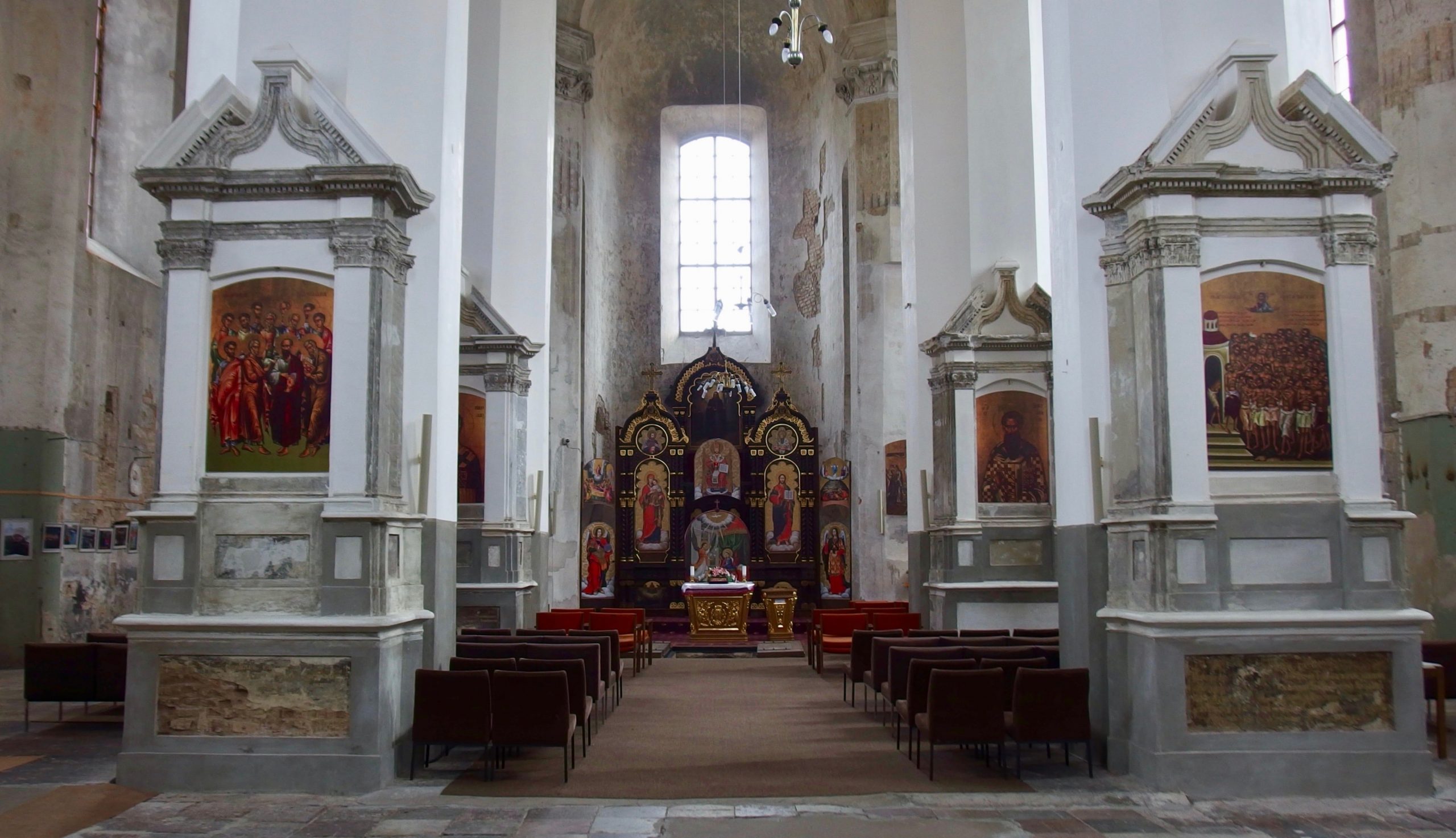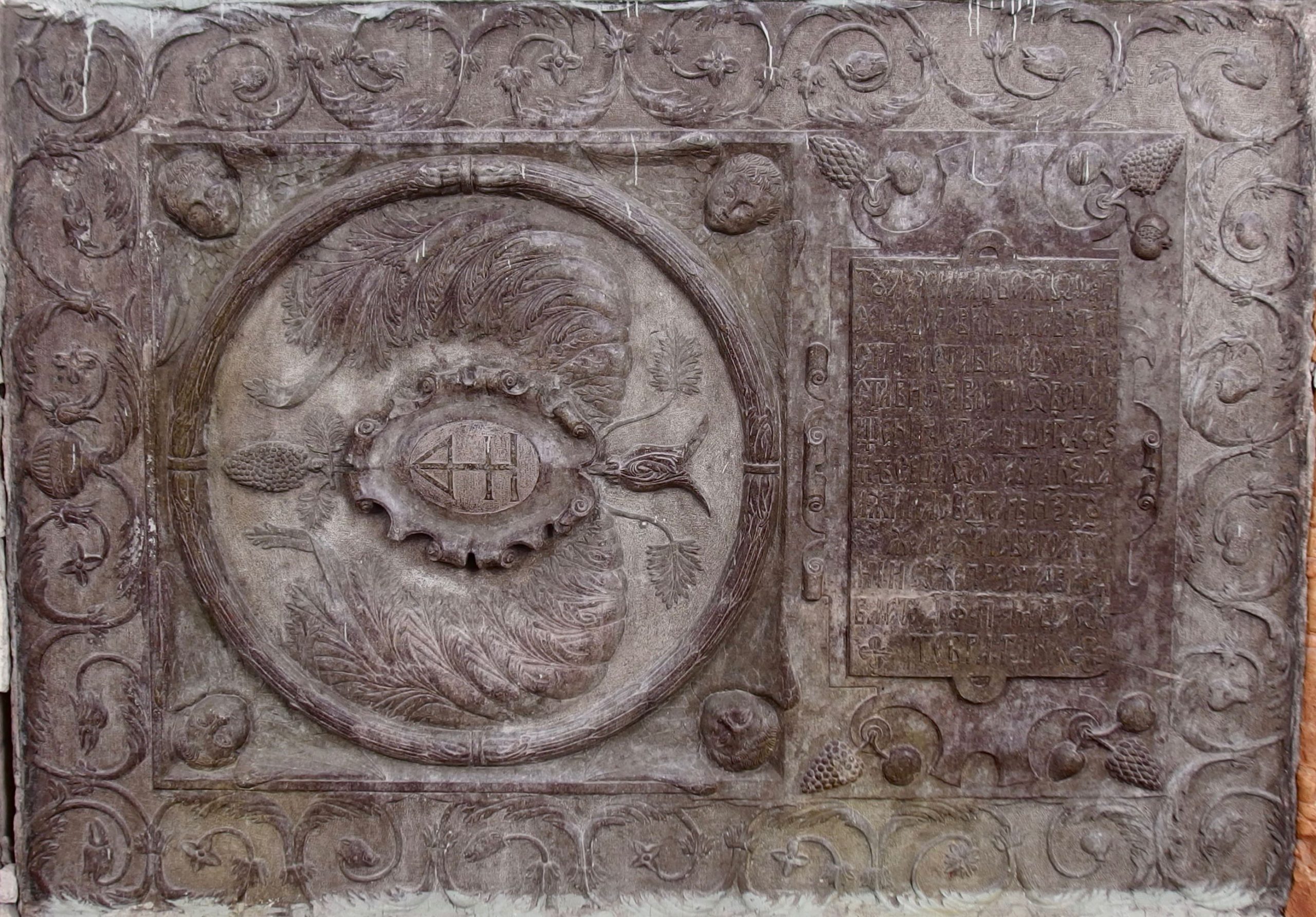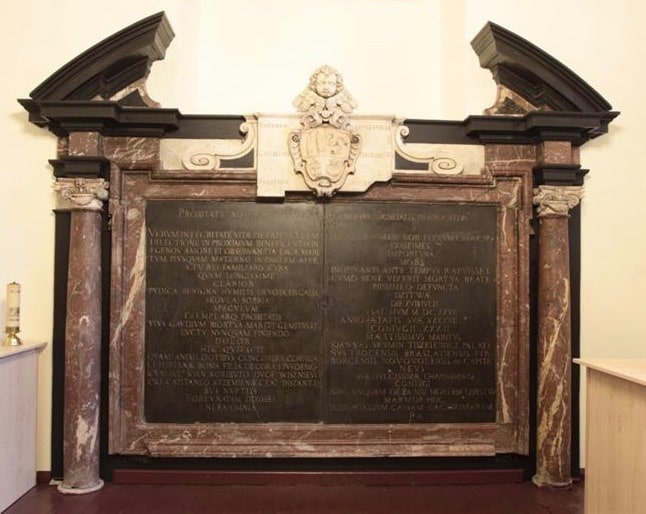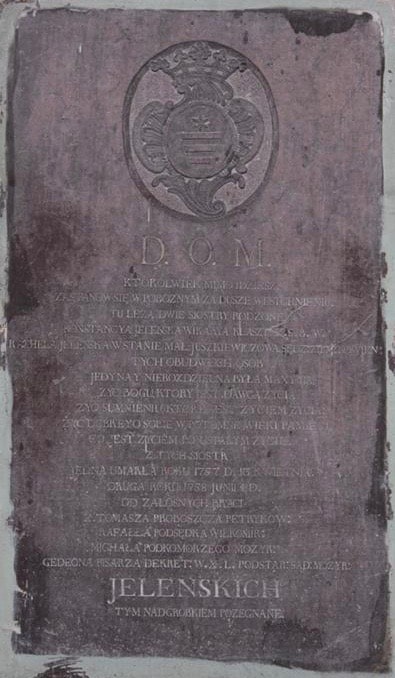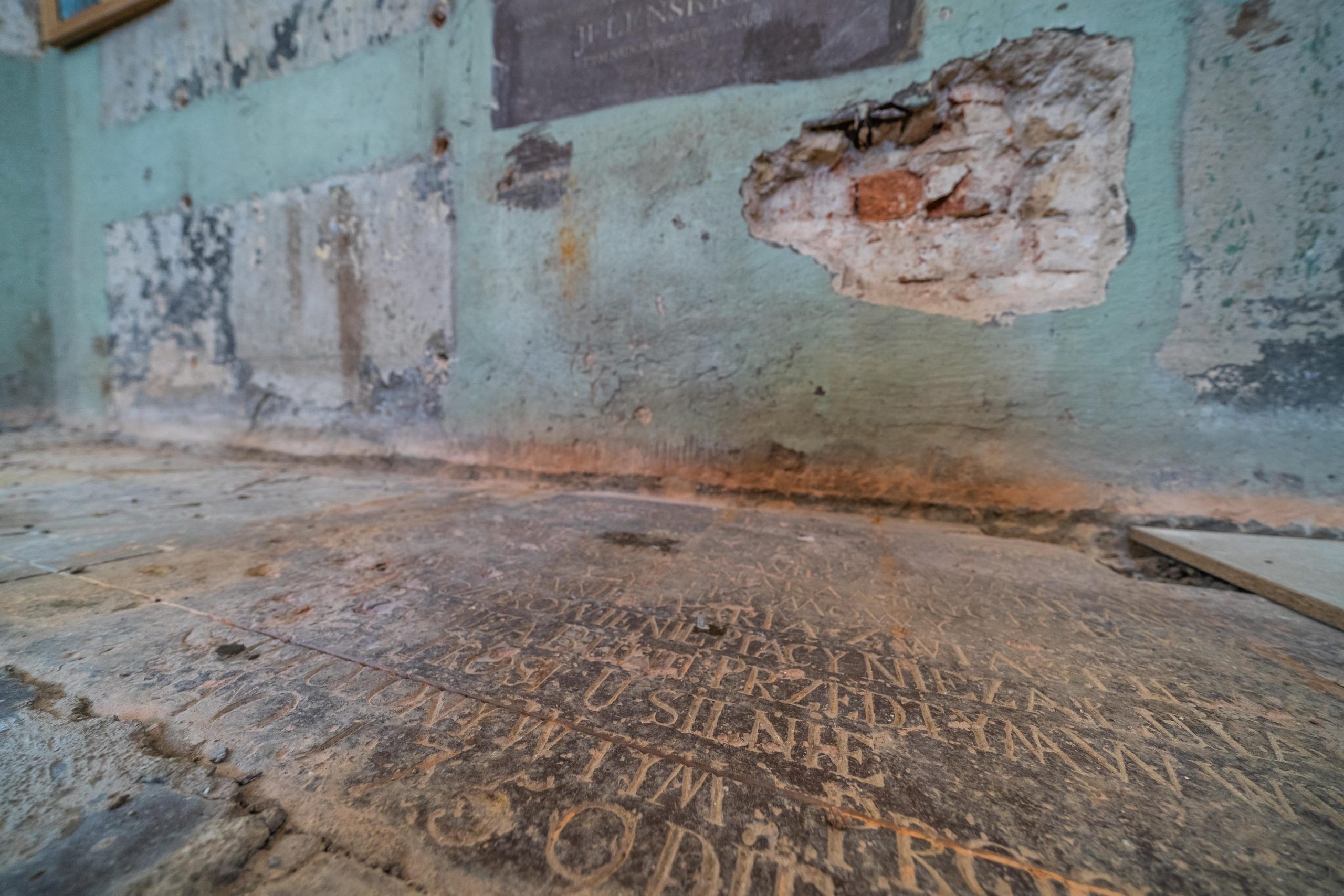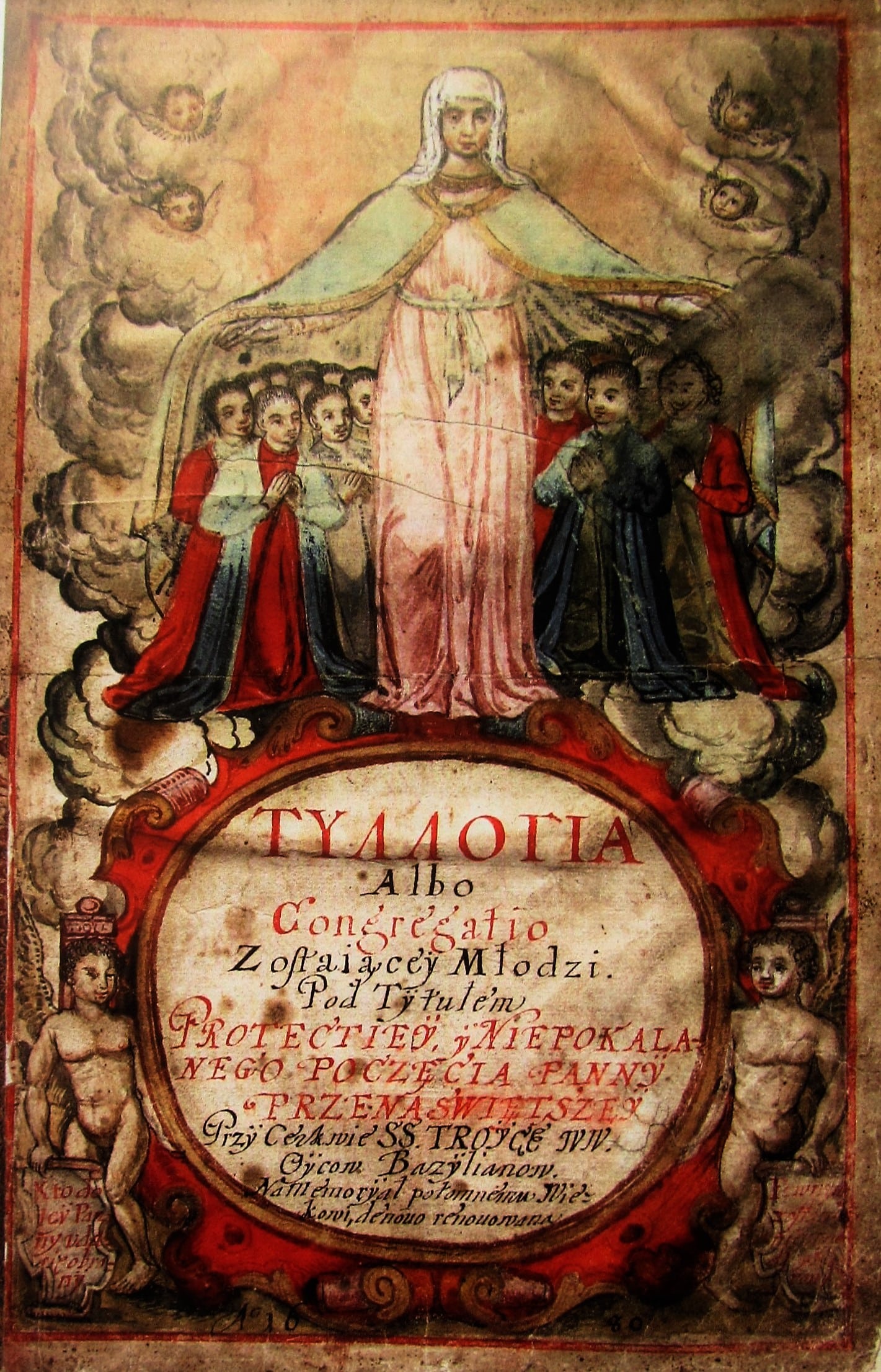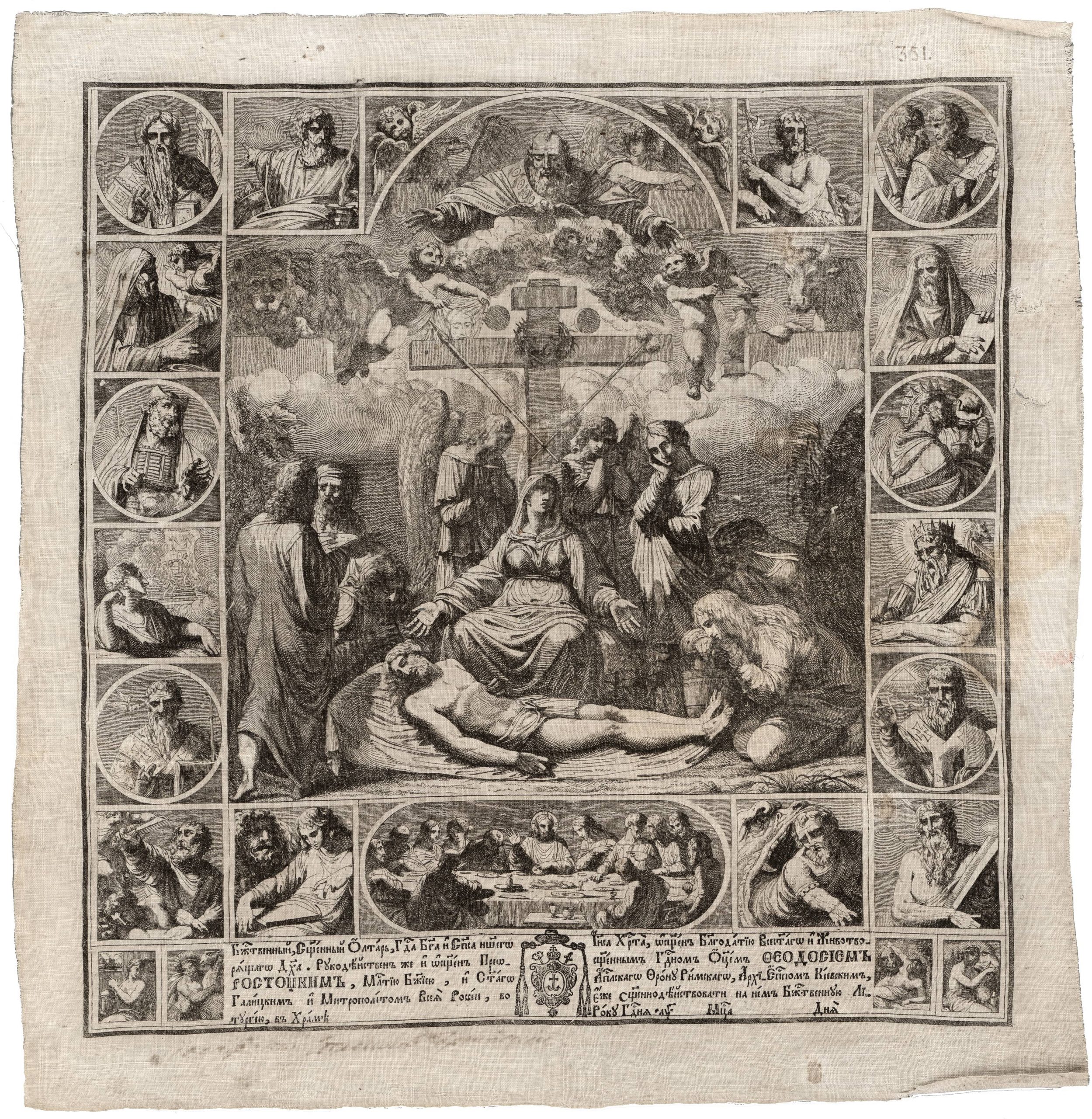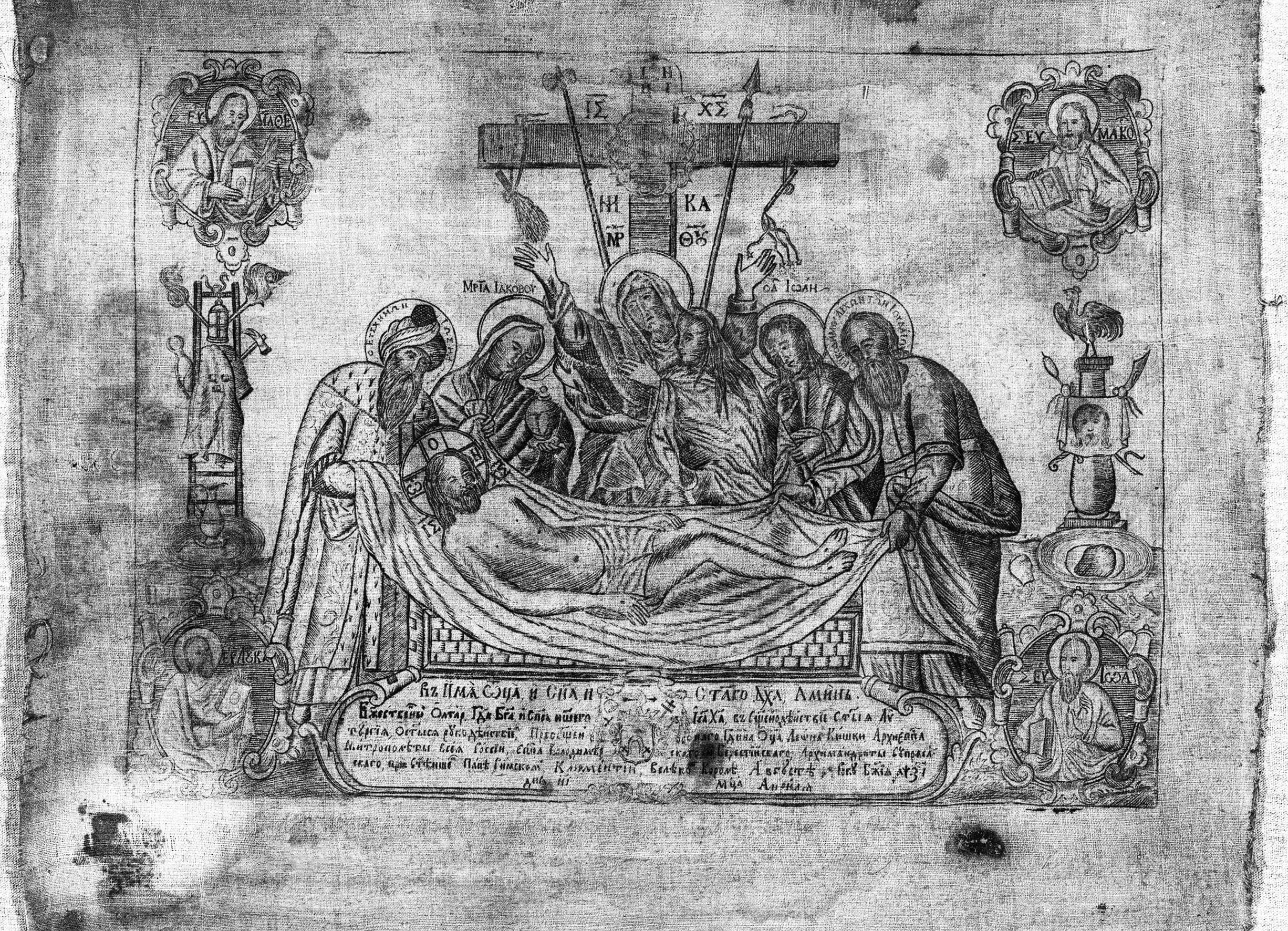Fires, tendencies to destroy Uniate art in the 19th century, and other dramatic turns of history have not allowed the artistic legacy of Holy Trinity Church in Vilnius and the monasteries that operated near it to survive to our times.
The interior walls of the church [1] are covered with layers of painting (polychromy) of various periods. Only remains of paintings from the oldest period (the first half of the 16th century) have been found. They appeared in niches in that part of the church where there are apses. The colorful ornamental wall paintings of the end of the 16th or start of the 17th centuries are best preserved. Their fragments are now best visible on the southern (right) wall [2, 3]. At the end of the 18th century, the shrine was adorned with decorative “optical” painting, which partially is visible to us in various places on the walls and vaults.1Rūta Janonienė, “Architektūrinis ansamblis”, in: Vadimas Adadurovas, et al., Kultūrų kryžkelė: Vilniaus Švč. Trejybės šventovė ir vienuolynas, moksl. red. Alfredas Bumblauskas, Salvijus Kulevičius, Ihoris Skočiliasas, Vilnius: Vilniaus universiteto leidykla, 2017, p. 216; same: Рута Янонєнє, “Архітектурний ансамбль”, in: Вадим Ададуров, et al., На перехресті культур. Монастир і храм Пресвятої Трійці у Вільнюсі (series: Київське християнство, т. 16), наук. ред. Альфредас Бумблаускас, Сальвіюс Кулявічюс, Ігор Скочиляс, Львів: Український католицький університет, 2019, с. 318–319. This layer was most likely applied before 1798, since in the visitation of that year some concern is expressed because the water leaking through the roof and windows was damaging the attractive painting.2Ibid. When one judges the style, these motifes of illusory architecture in rose shades can be attributed to the authorship of an artist from the circle of Franciszek Smuglewicz.3Ramunė Lebedytė, “Pranciškus Smuglevičius ir bazilijonai”, in: Pranciškus Smuglevičius ir jo epocha (series: Acta Academiae Artium Vilnensis = Vilniaus dailės akademijos darbai, t. 11), sud. Vidmantas Jankauskas, Vilnius: Vilniaus dailės akademijos leidykla, 1997, p. 51.
Near the pillars that support the vaults of the church there stand brick altars erected at the end of the 18th century. More than once redone, and then taken down, they created a harmonious ensemble and, according to descriptions, were fairly simple, classical: altar images were framed by columns or pilasters, at the top of the cornice decor in the form of pairs of plaster angels and vases [4]. Unfortunately, to the present not one icon from these altars has been found. A famed wonder-working icon of the Mother of God Hodigitria was taken to Moscow in 1915 and it is supposed that it was destroyed. Its image is known to us only through copies from other churches in Vilnius and lithographs and photographs from the second half of the 19th century (↑).
We also see some tombstones. A tombstone of the Braha family, prepared at the end of the 16th century, was later taken to the south wall of the church [5]. The family coat of arms is depicted on the left side of the stone, and on the right is a memorial inscription in the Old Ruthenian language, from which we learn that this is a memorial to burgomaster of Vilnius Anastazy Braha (+1576) and his son Antoni (+1580). The general composition of the stone, precise geometric figures that frame the coat of arms (a wreath of bay leaves and a square with the heads of angels in the corners), the Renaissance style of the floral ornament, which encircles the edges of the plate, and the frame with a motif of shackles around the inscription allow us to speak about the influence of the northern Renaissance or early Mannerism. This tombstone, unique, the only one preserved in Vilnius of this type, demonstrates the acceptance of Western European art in the culture of the Orthodox Ruthenians of the Grand Duchy of Lithuania and, at the same time, reflects the close relations of Holy Trinity Church with the Ruthenian part of the Vilnius Magistrate’s Office.4Leonidas Timošenka, “Švč. Trejybės stačiatikių vienuolynas”, in: Vadimas Adadurovas, op. cit., p. 65; same: Леонід Тимошенко, “Православний монастир Св. Трійці” in: Вадим Ададуров, op. cit., с. 92; Rūta Janonienė, op. cit., p. 212; same: с. 314.
The tombstone of Barbara Tyszkiewicz (Naruszewicz) (+1627) is preserved in the Chapel of the Annunciation of the Most Holy Mother of God (Skumin) [6]. The tombstone prepared in 1627–1632 is connected with Italian masters who worked in Vilnius, and most often with the name of Constante Tencalla.5Marija Matušakaitė, Išėjusiems atminti: laidosena ir kapų ženklinimas LDK, Vilnius: Vilniaus dailės akademijos leidykla, 2009, p. 179–180. The work incarnates the noble and restrained luxury of the early Baroque. Eventually, in times of various troubles, it experienced significant damage, and some of its parts were lost: over the columns of the memorial, neither of the plaster sculptures remain. (They are mentioned still in 1823.) Also, the strips that joined the columns below are gone. In the 19th century, some architectural details of the frame of the tombstone, “long removed from the walls and decayed”, are scattered throughout the whole chapel.6LMAVB, Rankraščių skyrius, f. 41, b. 83, l. 3; Ibid., b. 84, l. 3; Ibid., b. 222, l. 4v. The Chapel of the Skumins itself was erected before 1618, inasmuch as in this year the father-in-law of Barbara Teodor Skumin-Tyszkiewicz was buried in it, but in 1642 her husband, voievod of Vilnius Janush Skumin-Tyszkiewicz, who rebuilt this sacred structure, constructed a brick altar in it and provided it with liturgical vessels and other necessary items.7KPC PB, f. 5, ap. 1, b. 2314, l. 14, 37; Археографический сборник документов, относящихся к истории Северо-Западной Руси, издаваемый при управлении Виленскаго учебнаго округа, t. 10, Вильна: Печатня О. Блюмовича, 1874, p. 42.
On the north wall of the church is the epitath of sisters Konstancya Jelenska and Rachela Juszkewicz (Jelenska), created in the 1750s [7]. Konstancya, superior of the Basilian nuns’ monastery, died in 1757, and her sister, Rachela, the wife of the territorial judge of Kaunas, a year later. The monks ordered the memorial to them. The work is fairly modest. Attention is given to the family coat of arms and a long, sentimental inscription in the Polish language.
We know that in the church there was also a memorial to burgomaster of Vilnius Lukasz Hałłuza, who was buried here in 1759 [8].8LVIA, f. 1178, ap. 1, b. 105, l. 84.
Some valuable artistic items connected with Holy Trinity Church or the monastery ended up, through various paths, in a museum, library, or archive. In the Manuscripts Department of the Wroblewski Library of the Academy of Sciences of Lithuania, a book of the members of the Brotherhood of Youth of the Protection of the Mother of God and the Immaculate Conception of the Virgin Mary, which operated at Holy Trinity Church, is preserved. On the title sheet of the folio, a picture done by an unknown Basilian monk depicts the faithful, members of this brotherhood, gathered under the mantle of the Mother of God [9]. In the funds of the National Museum of Arts of Lithuania are gathered several antimensions of the 18th century, at least one of which was created from a picture by Smuglewicz [10, 11]; several paintings done in the middle of the 19th century by Jan Chrucki [12, 13]; and several seals of the Basilian Order [14].9Vladas Drėma, Pranciškus Smuglevičius, Vilnius: Vaga, 1973, p. 118; Ramunė Lebedytė, op. cit., p. 49.
Part of the valuable items from the sacristy and the treasury of Holy Trinity Church were lost, under various circumstances, already in the period of activity of the monastic center, but a number of them managed to be preserved to the 19th century. And then they were brutally destroyed as incongruous with Muscovite Orthodoxy. In regard to their past existence, documents about the gifting of real estate, inventories, and other written sources are the only witnesses now. But we still hope that some will be found. For example, one of the largest valuable items of the Basilian shrine, a silver monstrance, recently appeared in a church of Dūkštos (Vilnius district) [15].10Dangaus miestas. Vilniaus vienuolynų palikimas Bažnytinio paveldo muziejuje, sud. Dalia Vasiliūnienė, Vilnius: Bažnytinio paveldo muziejus, 2020, p. 177–178. The top is adorned with an image of the Holy Trinity and a cross, the bottom by a statuette of the Mother of God, and the sides with statuettes of St. Basil the Great and Blessed Josaphat.11LMAVB, Rankraščių skyrius, f. 41, b. 81, l. 9. They, likely, were created in approx. 1760 by Vilnius goldsmith Johann Larry. A symbol of the Holy Trinity and holy images confirm that this monstrance belonged to the Basilian treasury.
When one analyzes the exterior of the church, it is worth turning attention to the crosses which crown the towers, created by Vilnius smiths of the 19th century. A pair of such crosses on the back façade are older, but those that hang on the corners of the main façade were installed after 1869 [16].12Lietuvos TSR istorijos ir kultūros paminklų sąvadas, t. 1: Vilnius, Vilnius: Vyriausioji enciklopedijų redakcija, 1988, p. 237.
Rūta Janonienė
Išnašos:
| 1. | ↑ | Rūta Janonienė, “Architektūrinis ansamblis”, in: Vadimas Adadurovas, et al., Kultūrų kryžkelė: Vilniaus Švč. Trejybės šventovė ir vienuolynas, moksl. red. Alfredas Bumblauskas, Salvijus Kulevičius, Ihoris Skočiliasas, Vilnius: Vilniaus universiteto leidykla, 2017, p. 216; same: Рута Янонєнє, “Архітектурний ансамбль”, in: Вадим Ададуров, et al., На перехресті культур. Монастир і храм Пресвятої Трійці у Вільнюсі (series: Київське християнство, т. 16), наук. ред. Альфредас Бумблаускас, Сальвіюс Кулявічюс, Ігор Скочиляс, Львів: Український католицький університет, 2019, с. 318–319. |
|---|---|---|
| 2. | ↑ | Ibid. |
| 3. | ↑ | Ramunė Lebedytė, “Pranciškus Smuglevičius ir bazilijonai”, in: Pranciškus Smuglevičius ir jo epocha (series: Acta Academiae Artium Vilnensis = Vilniaus dailės akademijos darbai, t. 11), sud. Vidmantas Jankauskas, Vilnius: Vilniaus dailės akademijos leidykla, 1997, p. 51. |
| 4. | ↑ | Leonidas Timošenka, “Švč. Trejybės stačiatikių vienuolynas”, in: Vadimas Adadurovas, op. cit., p. 65; same: Леонід Тимошенко, “Православний монастир Св. Трійці” in: Вадим Ададуров, op. cit., с. 92; Rūta Janonienė, op. cit., p. 212; same: с. 314. |
| 5. | ↑ | Marija Matušakaitė, Išėjusiems atminti: laidosena ir kapų ženklinimas LDK, Vilnius: Vilniaus dailės akademijos leidykla, 2009, p. 179–180. |
| 6. | ↑ | LMAVB, Rankraščių skyrius, f. 41, b. 83, l. 3; Ibid., b. 84, l. 3; Ibid., b. 222, l. 4v. |
| 7. | ↑ | KPC PB, f. 5, ap. 1, b. 2314, l. 14, 37; Археографический сборник документов, относящихся к истории Северо-Западной Руси, издаваемый при управлении Виленскаго учебнаго округа, t. 10, Вильна: Печатня О. Блюмовича, 1874, p. 42. |
| 8. | ↑ | LVIA, f. 1178, ap. 1, b. 105, l. 84. |
| 9. | ↑ | Vladas Drėma, Pranciškus Smuglevičius, Vilnius: Vaga, 1973, p. 118; Ramunė Lebedytė, op. cit., p. 49. |
| 10. | ↑ | Dangaus miestas. Vilniaus vienuolynų palikimas Bažnytinio paveldo muziejuje, sud. Dalia Vasiliūnienė, Vilnius: Bažnytinio paveldo muziejus, 2020, p. 177–178. |
| 11. | ↑ | LMAVB, Rankraščių skyrius, f. 41, b. 81, l. 9. |
| 12. | ↑ | Lietuvos TSR istorijos ir kultūros paminklų sąvadas, t. 1: Vilnius, Vilnius: Vyriausioji enciklopedijų redakcija, 1988, p. 237. |
Sources of illustrations:
| 1. | Collection of VU IF. |
| 2. | Ibid. |
| 3. | Private collection of Salvijus Kulevičius. |
| 4. | Collection of VU IF. |
| 5. | Photographer Salvijus Kulevičius, 2017. Private collection of Salvijus Kulevičius. |
| 6. | Photographer Aloyzas Petrašiūnas, 2011. Held in: KPC PB. Published: „Vilniaus bazilijonų vienuolyno statinių ansamblio Švč. Trejybės bažnyčia“ [unique code: 27316], in: Kultūros vertybių registras, available at: https://kvr.kpd.lt/#/static-heritage-detail/D74C79BB-D879-4A9F-981B-9268C7FEAE79, photograph no. 99 or 83, accessed: 2021 12 01. |
| 7. | Photographer Aloyzas Petrašiūnas, 2011. Held in: KPC PB. Published: „Vilniaus bazilijonų vienuolyno statinių ansamblio Švč. Trejybės bažnyčia…“, photograph no. 86 or 70, accessed: 2021 12 01. |
| 8. | Photographer Edgaras Kurauskas, 2021. Collection of VU IF. |
| 9. | Held in: LMAVB, Rankraščių skyrius, F22-75, l. 1. |
| 10. | Held in: LNDM, LNDM G 756/a (Available at: Lietuvos integrali muziejų informacinė sistema, www.limis.lt/greita-paieska/perziura/-/exhibit/preview/20000005761943?s_id=jnnZ5lzLpLshdOPu&s_ind=1&valuable_type=EKSPONATAS, accessed: 2021 12 01). |
| 11. | Held in: НМЛ, Відділ графіки, Гд-131. |
| 12. | Held in: LNDM, LNDM T 916 (Available at: Lietuvos integrali muziejų informacinė sistema, www.limis.lt/greita-paieska/perziura/-/exhibit/preview/20000003481024?s_id=AZq9XXgk7kD2NJFu&s_ind=1&valuable_type=EKSPONATAS, accessed: 2021 12 01). |
| 13. | Held in: LNDM, LNDM T 547 (Available at: Lietuvos integrali muziejų informacinė sistema, www.limis.lt/greita-paieska/perziura/-/exhibit/preview/20000001581602?s_id=wDOOKtSsDBkDtgsB&s_ind=1&valuable_type=EKSPONATAS, accessed: 2021 12 01). |
| 14. | Held in: LNDM, LNDM MPM 210 (Available at: Lietuvos integrali muziejų informacinė sistema, www.limis.lt/greita-paieska/perziura/-/exhibit/preview/20000004589540?s_id=EWhnvumrJoxYHYox&s_ind=1&valuable_type=EKSPONATAS, accessed: 2021 12 01). |
| 15. | Held in: BPM, BPM B 330. Published: Birutė Rūta Vitkauskienė, Złotnictwo wileńskie. Ludzie i dzieła XV–XVIII wiek, Warszawa: Neriton, 2006, p. 287; Vilniaus sakralinė auksakalystė, sud. Rita Pauliukevičiūtė, Vilnius: Bažnytinio paveldo muziejus, 2012, kat. 90, p. 98; Dangaus miestas. Vilniaus vienuolynų palikimas Bažnytinio paveldo muziejuje, sud. Dalia Vasiliūnienė, Vilnius: Bažnytinio paveldo muziejus, 2020, p. 177. |
| 16. | Collection of VU IF. |
